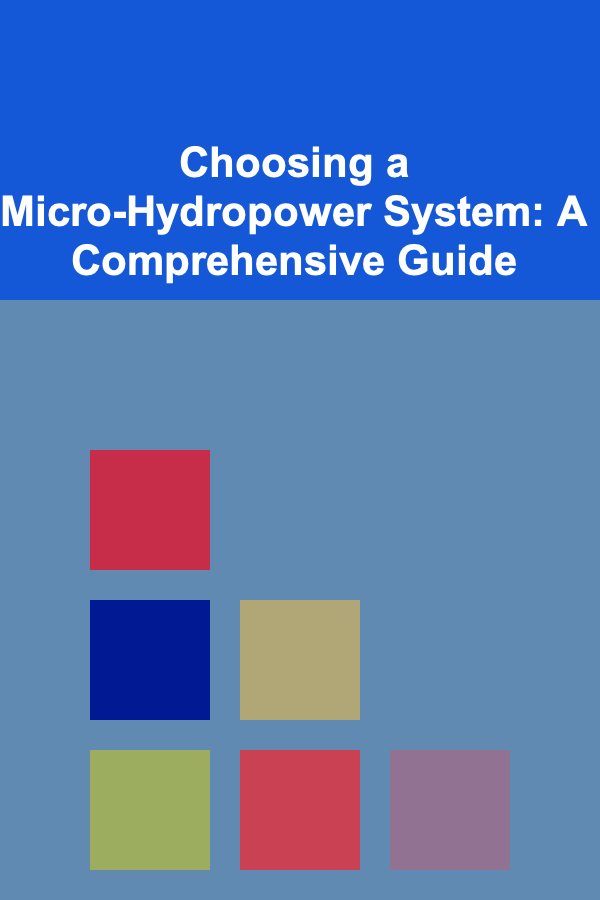
Choosing a Micro-Hydropower System: A Comprehensive Guide
ebook include PDF & Audio bundle (Micro Guide)
$12.99$10.99
Limited Time Offer! Order within the next:

Micro-hydropower, the generation of electricity using the energy of flowing water on a small scale, offers a compelling solution for individuals, farms, and small communities seeking sustainable and reliable power. Unlike large-scale hydroelectric dams, micro-hydropower systems have a minimal environmental footprint and can be implemented in a variety of locations. However, selecting the right micro-hydropower system requires careful consideration of several factors. This comprehensive guide will walk you through the process, from assessing your resource potential to choosing the appropriate turbine technology and navigating regulatory hurdles.
Assessing Your Hydropower Resource: The Foundation for Success
Before even considering specific turbines or system components, a thorough assessment of your water resource is absolutely crucial. This assessment determines the feasibility of a micro-hydropower project and informs all subsequent decisions. Underestimating or miscalculating your resource can lead to significant performance issues or even project failure. The two key metrics to measure are head and flow.
1.1 Understanding Head: The Vertical Drop
Head refers to the vertical distance the water falls between the intake point (where the water enters the system) and the turbine. It's essentially the potential energy that will be converted into kinetic energy. Head is typically measured in meters or feet. A higher head generally translates to more power potential, even with a smaller flow rate. There are two types of head to consider:
- Gross Head: The total vertical distance between the water surface at the intake and the water surface at the turbine discharge. This is the theoretical maximum head.
- Net Head: The gross head minus any losses due to friction in the penstock (the pipe carrying water to the turbine). This is the actual head available to the turbine.
Measuring head accurately is critical. Methods include:
- Altimeter/GPS Devices: While convenient, these devices can be inaccurate, especially in areas with dense tree cover. They provide a quick estimate but should not be relied upon for precise measurements.
- Surveying Equipment (Level and Rod): This is the most accurate method for measuring head. A level and rod are used to measure the vertical distance between points along the stream or river. This method requires some surveying knowledge or the assistance of a professional surveyor.
- Pressure Transducers: These devices measure the pressure at the turbine inlet, which can be converted to head. They require careful calibration and installation but can provide continuous head measurements.
After obtaining head measurements, subtract any losses that will occur from the penstock. Estimating penstock losses is discussed later in this guide.
1.2 Measuring Flow: The Volume of Water
Flow rate, measured in liters per second (L/s) or cubic feet per second (cfs), represents the volume of water passing a given point in a given time. Flow is equally important as head; a high head with insufficient flow will not generate much power, and vice versa. Accurate flow measurement is essential for sizing the turbine and determining the power potential of your site.
Several methods can be used to measure flow:
- Bucket and Stopwatch Method: This is a simple and inexpensive method for small streams. A bucket of known volume is placed in the stream to collect water, and the time it takes to fill the bucket is measured. The flow rate is then calculated as volume/time. Multiple measurements should be taken and averaged for accuracy.
- Weir Method: A weir is a dam or obstruction with a precisely shaped notch. The height of the water flowing over the weir is measured, and the flow rate is calculated using a standard weir equation. Different weir shapes (rectangular, V-notch, trapezoidal) are suitable for different flow ranges. Weirs are relatively inexpensive and accurate, but require some installation effort.
- Flume Method: A flume is a specially shaped channel that constricts the flow of water. The depth of the water at a specific point in the flume is measured, and the flow rate is calculated using a flume equation. Flumes are less sensitive to debris and backwater effects than weirs.
- Flow Meter: Various types of flow meters can be used to measure stream flow, including propeller meters, ultrasonic meters, and electromagnetic meters. Flow meters can provide continuous flow measurements and are often used for larger streams. However, they can be more expensive than other methods and may require professional installation.
Seasonal Flow Variation: It's crucial to measure flow rates throughout the year to understand seasonal variations. Low flow periods, typically during dry seasons, will limit the amount of power you can generate. You should design your system based on the minimum flow rate you can reliably expect. Consider using long-term historical data from nearby gauging stations if available.
1.3 Calculating Power Potential
Once you have accurate measurements of head and flow, you can estimate the potential power output of your site. The formula for calculating theoretical power is:
Power (Watts) = Head (meters) x Flow (Liters/second) x Gravity (9.81 m/s²) x Efficiency
Or, if using feet and cubic feet per second:
Power (Watts) = Head (feet) x Flow (Cubic Feet/second) x 8.05 x Efficiency
The efficiency term accounts for losses in the turbine, generator, and other system components. A typical overall efficiency for a well-designed micro-hydropower system ranges from 50% to 80%. A conservative estimate of 60-70% is often used during initial calculations. This calculation provides an estimate of the theoretical maximum power available. The actual power output will depend on the efficiency of the chosen turbine and the overall system design.
Choosing the Right Turbine Technology: Matching Turbine to Resource
The choice of turbine is a critical decision, as it directly impacts the efficiency and reliability of your system. Different turbine types are best suited for different head and flow conditions. Selecting the wrong turbine can result in poor performance and reduced power output.
2.1 Turbine Types: A Categorical Overview
Micro-hydropower turbines can be broadly classified into two main categories: impulse turbines and reaction turbines.
2.1.1 Impulse Turbines: Harnessing Kinetic Energy
Impulse turbines convert the potential energy of the water into kinetic energy (velocity) before it strikes the turbine blades. The water jet impacts the blades, causing the turbine to rotate. Impulse turbines are generally best suited for high-head, low-flow applications.
- Pelton Turbine: The Pelton turbine is the most common type of impulse turbine. It consists of a wheel with bucket-shaped blades. One or more jets of water are directed at the buckets, causing the wheel to rotate. Pelton turbines are very efficient at high head and low flow rates. They are relatively simple in design and can be scaled to different sizes. Ideal for heads above 50 meters (164 feet).
- Turgo Turbine: The Turgo turbine is a variation of the Pelton turbine. The water jet strikes the blades at an angle, allowing for a higher flow rate than a Pelton turbine for the same head. Turgo turbines are suitable for medium-head, medium-flow applications. Generally used for heads between 30 and 300 meters (98-984 feet).
- Cross-Flow (Banki) Turbine: The Cross-Flow turbine is a drum-shaped turbine with curved blades. Water flows through the turbine twice, first from the outside to the inside, and then from the inside to the outside. Cross-Flow turbines are relatively inexpensive and can operate over a wide range of head and flow conditions. However, their efficiency is generally lower than Pelton or Turgo turbines. Well-suited for low-head applications (1-200 meters or 3-656 feet), especially where flow varies significantly.
2.1.2 Reaction Turbines: Harnessing Pressure Energy
Reaction turbines utilize both the pressure and kinetic energy of the water. The turbine blades are submerged in water, and the pressure difference between the upstream and downstream sides of the blades causes the turbine to rotate. Reaction turbines are generally best suited for low-head, high-flow applications.
- Francis Turbine: The Francis turbine is a mixed-flow turbine, meaning that the water enters the turbine radially and exits axially. Francis turbines are very efficient and can operate over a wide range of head and flow conditions. However, they are more complex in design and are typically used for larger-scale hydropower projects. Most efficient for medium head ranges, from 20 to 300 meters (66-984 feet).
- Kaplan Turbine: The Kaplan turbine is an axial-flow turbine with adjustable blades. The blade angle can be adjusted to optimize efficiency for different flow rates. Kaplan turbines are well-suited for low-head, high-flow applications with variable flow rates. Ideal for heads below 40 meters (131 feet) and large flow volumes.
- Propeller Turbine: A fixed-blade version of the Kaplan. Cheaper, but less efficient at varying flow rates.
2.2 Matching Turbine Type to Site Characteristics
The following table provides a general guideline for selecting the appropriate turbine type based on head and flow:
(Note: These are approximate ranges. Consult with a hydropower specialist for specific recommendations.)
- High Head ( > 50 meters/164 feet), Low Flow: Pelton Turbine
- Medium Head (30-300 meters/98-984 feet), Medium Flow: Turgo Turbine
- Low to Medium Head (1-200 meters/3-656 feet), Variable Flow: Cross-Flow (Banki) Turbine
- Medium Head (20-300 meters/66-984 feet), Medium to High Flow: Francis Turbine
- Low Head ( < 40 meters/131 feet), High Flow: Kaplan or Propeller Turbine
In addition to head and flow, consider the following factors when choosing a turbine:
- Sediment Load: High sediment concentrations in the water can cause erosion and damage to turbine blades. Impulse turbines are generally more tolerant of sediment than reaction turbines.
- Debris: Debris such as leaves, branches, and rocks can clog the turbine and reduce its efficiency. Screens and trash racks should be installed at the intake to prevent debris from entering the system.
- Maintenance Requirements: Some turbines require more maintenance than others. Consider the availability of spare parts and qualified technicians in your area.
- Cost: The cost of the turbine is a significant factor in the overall project cost. Balance the cost of the turbine with its efficiency and reliability.
2.3 Considerations for Grid-Tied vs. Off-Grid Systems
The intended use of the electricity generated also influences turbine selection. Are you planning to connect to the grid (grid-tied) or operate independently (off-grid)?
- Grid-Tied Systems: These systems require a synchronous generator or an inverter to convert the DC power from the turbine to AC power that is compatible with the grid. The turbine must maintain a stable frequency (typically 50 or 60 Hz) to synchronize with the grid. Grid-tied systems often benefit from the stability and predictability of the grid, but must comply with utility regulations.
- Off-Grid Systems: These systems typically use a battery bank to store electricity for later use. The turbine charges the batteries, and an inverter converts the DC power from the batteries to AC power for household appliances or other loads. Off-grid systems require careful sizing of the battery bank and inverter to meet the energy demands of the user. Turgo and Cross-Flow turbines are often favored in off-grid scenarios due to their ability to handle fluctuating flow rates.
Key System Components: Building a Complete Hydropower System
Beyond the turbine, a micro-hydropower system comprises several other crucial components that work together to generate and deliver electricity.
3.1 Intake Structure: Capturing the Water
The intake structure is responsible for diverting water from the stream or river into the penstock. The design of the intake structure should minimize disturbance to the aquatic environment and prevent debris from entering the system.
- Location: The intake should be located in a stable area of the stream or river, away from areas prone to erosion or sedimentation.
- Screening: Screens and trash racks should be installed at the intake to prevent debris from entering the penstock and damaging the turbine. The mesh size of the screens should be small enough to prevent fish and other aquatic organisms from being drawn into the system.
- Intake Type: Different types of intakes can be used, depending on the size of the stream and the flow rate required. Common types include diversion weirs, side intakes, and bottom intakes.
3.2 Penstock: Conveying the Water
The penstock is the pipe that carries water from the intake to the turbine. The penstock should be sized appropriately to minimize friction losses and maintain a sufficient flow rate to the turbine.
- Material: Common penstock materials include PVC, HDPE, steel, and concrete. The choice of material depends on the pressure, flow rate, and environmental conditions. HDPE (High-Density Polyethylene) is often favored for its flexibility, durability, and ease of installation.
- Diameter: The diameter of the penstock should be large enough to minimize friction losses but small enough to be cost-effective. The optimal diameter can be calculated using hydraulic equations, taking into account the flow rate, penstock length, and material. A smaller diameter increases head loss due to friction but is cheaper.
- Length: Minimize the length of the penstock to reduce friction losses. However, sometimes a longer penstock is necessary to achieve the desired head.
- Penstock Support: Proper support for the penstock is essential to prevent sagging, damage, and leaks. The penstock should be anchored securely to the ground at regular intervals.
3.3 Turbine and Generator: Converting Mechanical Energy to Electricity
The turbine converts the kinetic energy of the water into mechanical energy, which is then used to drive a generator. The generator converts the mechanical energy into electrical energy.
- Turbine Selection: As discussed earlier, the turbine type should be carefully selected based on the head and flow characteristics of the site.
- Generator Type: Generators can be synchronous or asynchronous (induction). Synchronous generators are typically used for grid-tied systems, while asynchronous generators are often used for off-grid systems. Permanent magnet generators (PMGs) are also becoming increasingly popular due to their high efficiency and low maintenance requirements.
- Power Output: The power output of the generator should be matched to the energy demands of the user or the grid. Oversizing the generator can lead to inefficiencies, while undersizing the generator can limit the amount of power that can be generated.
3.4 Control System: Managing the System
The control system monitors and regulates the operation of the micro-hydropower system. The control system can include sensors, actuators, and a programmable logic controller (PLC). It's responsible for:
- Speed Control: Maintaining a stable turbine speed is critical for efficient and reliable operation. The control system adjusts the flow of water to the turbine to maintain the desired speed.
- Voltage and Frequency Regulation: For grid-tied systems, the control system regulates the voltage and frequency of the electricity generated to match the grid standards.
- Protection: The control system protects the turbine and generator from overloads, short circuits, and other faults.
- Data Logging: The control system can log data such as power output, flow rate, and turbine speed. This data can be used to monitor the performance of the system and identify any problems.
3.5 Transmission and Distribution: Delivering the Electricity
The electricity generated by the micro-hydropower system must be transmitted to the point of use. This may involve wiring to a nearby building or connecting to the grid.
- Wiring: The wiring should be sized appropriately to handle the current flow without overheating. Consult with a qualified electrician to ensure that the wiring meets all applicable safety codes.
- Grid Interconnection: Connecting to the grid requires a grid interconnection agreement with the local utility. The utility may have specific requirements for the type of generator, protection equipment, and metering.
- Off-Grid Distribution: For off-grid systems, the electricity is typically distributed through a local electrical system. This may involve wiring to a household or business.
Navigating Regulatory Requirements and Environmental Considerations
Micro-hydropower projects are subject to various regulatory requirements and environmental considerations. It is essential to obtain all necessary permits and approvals before starting construction.
4.1 Permitting and Licensing
The specific permitting requirements will vary depending on the location and size of the project. Common permits and licenses may include:
- Water Rights Permit: This permit grants the right to divert water from the stream or river for hydropower generation.
- Construction Permit: This permit authorizes the construction of the intake structure, penstock, and powerhouse.
- Environmental Permit: This permit ensures that the project complies with all applicable environmental regulations.
- Grid Interconnection Agreement: This agreement is required to connect the micro-hydropower system to the grid.
Start the permitting process early in the project planning phase. The permitting process can be lengthy and complex, so it is important to allow sufficient time for obtaining all necessary approvals.
4.2 Environmental Impact Assessment
An environmental impact assessment (EIA) may be required to assess the potential environmental impacts of the project. The EIA should consider the following:
- Impact on Aquatic Life: The project should minimize impacts on fish and other aquatic organisms. This may involve installing fish screens at the intake and maintaining a minimum flow in the stream or river.
- Impact on Water Quality: The project should not degrade water quality. This may involve implementing erosion control measures and preventing pollution from construction activities.
- Impact on Riparian Habitat: The project should minimize impacts on riparian vegetation and wildlife. This may involve preserving riparian buffers and avoiding construction during sensitive periods.
- Impact on Aesthetics: The project should be designed to minimize its visual impact on the landscape.
Consult with environmental agencies and local communities to address any concerns about the environmental impacts of the project.
4.3 Minimizing Environmental Footprint
Micro-hydropower offers a relatively clean source of energy, but minimizing its environmental footprint requires proactive measures.
- Run-of-River Systems: Prioritize run-of-river systems that do not require a large dam or reservoir. These systems divert a portion of the stream flow through the turbine and return it to the stream downstream.
- Fish Passage: Incorporate fish passage structures to allow fish to migrate upstream and downstream past the intake.
- Minimum Flow Requirements: Maintain a minimum flow in the stream or river to protect aquatic life and water quality. Consult with regulatory agencies to determine the appropriate minimum flow requirement.
- Erosion Control: Implement erosion control measures during construction to prevent sediment from entering the stream or river.
- Habitat Restoration: Restore any disturbed habitat during construction to minimize the long-term environmental impacts of the project.
Economic Considerations and Financial Planning
The economic viability of a micro-hydropower project depends on several factors, including the cost of the system, the amount of electricity generated, and the value of the electricity. A thorough financial analysis is essential to determine whether the project is a worthwhile investment.
5.1 Cost Estimation
The cost of a micro-hydropower system can vary widely depending on the size of the system, the type of turbine, and the site conditions. Major cost components include:
- Turbine and Generator: The cost of the turbine and generator is typically the largest cost component of the system.
- Intake Structure: The cost of the intake structure depends on the size and complexity of the structure.
- Penstock: The cost of the penstock depends on the material, diameter, and length of the penstock.
- Control System: The cost of the control system depends on the complexity of the system.
- Wiring and Grid Interconnection: The cost of wiring and grid interconnection depends on the distance to the point of use and the utility requirements.
- Permitting and Licensing: The cost of permitting and licensing can vary depending on the location and size of the project.
- Installation: The cost of installation depends on the complexity of the system and the availability of skilled labor.
- Engineering and Consulting: The cost of engineering and consulting services can vary depending on the complexity of the project.
Obtain detailed cost estimates from qualified suppliers and contractors before making any decisions.
5.2 Revenue Generation
The revenue generated by a micro-hydropower system depends on the amount of electricity generated and the value of the electricity. Revenue streams may include:
- Net Metering: If the system is connected to the grid, the owner may be able to sell excess electricity back to the utility through a net metering agreement.
- Feed-in Tariffs: Some jurisdictions offer feed-in tariffs (FITs), which are guaranteed prices for electricity generated from renewable sources.
- Reduced Electricity Bills: If the system is used to power a home or business, it can reduce electricity bills.
- Renewable Energy Certificates (RECs): Some jurisdictions allow the sale of RECs, which represent the environmental benefits of generating renewable energy.
5.3 Financial Analysis
A financial analysis should be conducted to determine the economic viability of the project. The financial analysis should consider the following:
- Capital Costs: The total cost of the project, including all equipment, installation, and permitting costs.
- Operating Costs: The annual cost of operating and maintaining the system.
- Revenue: The annual revenue generated by the system.
- Payback Period: The time it takes for the system to pay for itself.
- Return on Investment (ROI): The percentage return on the investment in the system.
- Net Present Value (NPV): The present value of the future cash flows generated by the system, minus the initial investment.
A positive NPV indicates that the project is economically viable. Consult with a financial advisor to conduct a thorough financial analysis.
5.4 Funding Opportunities
Various funding opportunities may be available to help finance a micro-hydropower project. These may include:
- Government Grants: Many government agencies offer grants for renewable energy projects.
- Tax Credits: Tax credits may be available for investments in renewable energy.
- Loans: Loans may be available from banks and other financial institutions.
- Private Investors: Private investors may be willing to invest in micro-hydropower projects.
Installation, Maintenance, and Long-Term Operation
Proper installation and regular maintenance are essential for ensuring the long-term reliability and performance of a micro-hydropower system.
6.1 Installation
The installation of a micro-hydropower system should be performed by qualified professionals. The installation process should follow the manufacturer's instructions and all applicable safety codes.
- Site Preparation: The site should be properly prepared before installation begins. This may involve clearing vegetation, leveling the ground, and excavating trenches for the penstock and wiring.
- Equipment Installation: The equipment should be installed according to the manufacturer's instructions. This includes the intake structure, penstock, turbine, generator, control system, and wiring.
- Testing and Commissioning: The system should be thoroughly tested and commissioned before being put into operation. This ensures that all components are working properly and that the system is generating electricity as expected.
6.2 Maintenance
Regular maintenance is essential for ensuring the long-term reliability and performance of a micro-hydropower system. Maintenance tasks may include:
- Inspection: Regularly inspect the system for any signs of wear or damage.
- Cleaning: Clean the intake screens and turbine blades regularly to remove debris.
- Lubrication: Lubricate the turbine and generator bearings regularly.
- Tightening: Tighten any loose bolts or connections.
- Repairs: Repair any damaged components promptly.
Develop a maintenance schedule and keep records of all maintenance activities.
6.3 Long-Term Operation
With proper installation and maintenance, a micro-hydropower system can provide a reliable source of electricity for many years. However, it is important to monitor the performance of the system and make any necessary adjustments to ensure optimal operation.
- Performance Monitoring: Monitor the power output of the system and compare it to the expected output. Investigate any significant deviations from the expected output.
- Data Logging: Use the control system to log data such as power output, flow rate, and turbine speed. This data can be used to monitor the performance of the system and identify any problems.
- Adaptive Management: Be prepared to adapt the system to changing conditions. This may involve adjusting the flow rate to the turbine, modifying the intake structure, or upgrading the equipment.
Conclusion: Empowering Communities with Micro-Hydropower
Choosing and implementing a micro-hydropower system is a complex undertaking that requires careful planning, thorough assessment, and a commitment to long-term operation and maintenance. However, the rewards of a successful micro-hydropower project are significant: a sustainable, reliable, and environmentally friendly source of electricity that can empower individuals, farms, and communities for years to come. By carefully considering the factors outlined in this guide, you can make informed decisions and build a micro-hydropower system that meets your specific needs and contributes to a cleaner and more sustainable energy future. Don't hesitate to consult with experienced hydropower professionals and engineers throughout the process to ensure the success of your project.

How to Build Client Relationships for Long-Term Fitness Coaching Success
Read More
How to Create a Financial Plan for Your Family's Future
Read More
How to Maintain Consistency in Product Quality with Your Dropshipping Suppliers
Read More
How to Organize Kitchen Essentials in a Rental Property
Read More
Turning Your Deep Learning Skills into Passive Income
Read More
How to Launch a Successful Local Artisan Market
Read MoreOther Products

How to Build Client Relationships for Long-Term Fitness Coaching Success
Read More
How to Create a Financial Plan for Your Family's Future
Read More
How to Maintain Consistency in Product Quality with Your Dropshipping Suppliers
Read More
How to Organize Kitchen Essentials in a Rental Property
Read More
Turning Your Deep Learning Skills into Passive Income
Read More